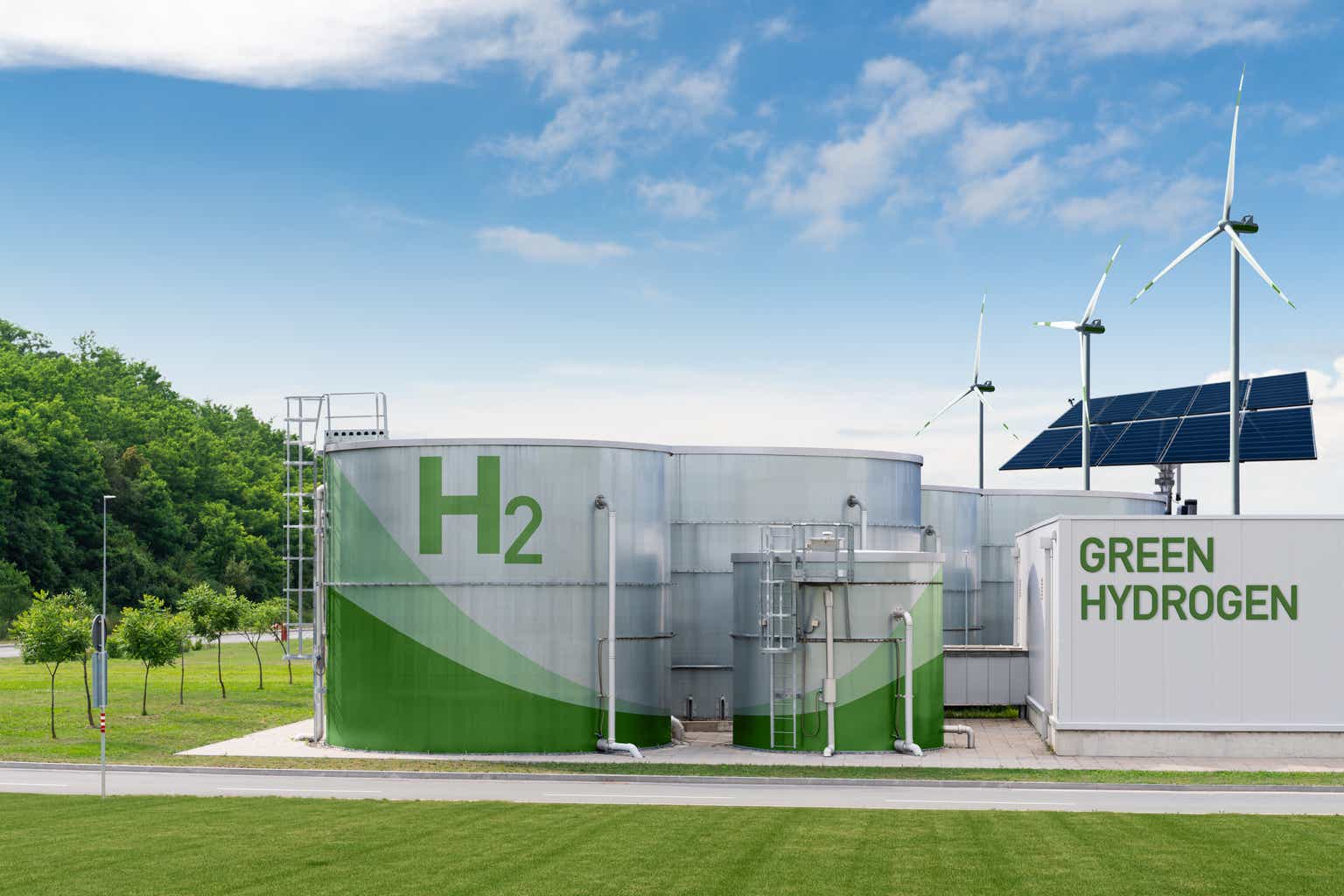Back in April, I wrote that I’d stay away from Plug Power (NASDAQ:PLUG) until it can better prove itself, while more recently I wrote in September that PLUG’s poor track record and delays in plant construction make it difficult to have confidence in its future success. The stock is down nearly -60% from my original write-up and over -40% since my last article. Let’s catch up on the name.
Company Profile
As a reminder, PLUG is in the process of trying to develop a hydrogen ecosystem that includes everything from hydrogen production, storage, and delivery to energy distribution. Currently, though, its main product is its GenDrive fuel cell that is used in forklifts and other material handling equipment. These fuel cells are commonly used in high volume warehouses and distribution centers that operate around the clock. It also sells electrolyzers and engineered equipment.
The company is in the process of building out several hydrogen plants. It also owns a 155,000-square-foot gigafactory in Rochester, New York and a 407,000-square-foot facility in Slingerlands, New York.
Q3 Results and New Facility Progress
The biggest issue PLUG faces is that it has negative gross margins because it sells the hydrogen to power its fuel cells at a big discount. This problem only worsened in Q3.
For its most-recent quarter reported last month, PLUG saw revenue rise 5% to $198.7 million. Equipment and related infrastructure sales. however, fell -8% to $145.1 million. Within that line item, fuel cell sales dropped in half to $37.7 million. Electrolyzer sales soared from $6.8 million to $26.6 million, while engineered equipment sales dropped from $25.6 million to $7.2 million. Sales of cryogenic equipment climbed for $12.5 million to $35.4 million.
Gross margins were an abysmal -69.5% compared to -24.4% a year ago. Equipment gross margins were -9.6% versus 19.4% a year ago.
PLUG blamed the dismal gross margins on a historically difficult hydrogen supply environment caused by a number of frequent force majeure events. It did note that it did, however, see margin expansion in some new products. Its own Tennessee plant, which provides about 20% of its hydrogen, was part of the problem, while the company noted that fueling stations in California were without fuel or had limited fuel for several months, forcing the company to transport hydrogen from the east coast to the west coast.
Given its inability to supply hydrogen fuel at a profit, PLUG’s only path to profitability is to build out a hydrogen production ecosystem where it can produce green hydrogen at scale and at a profit.
The company has four green hydrogen plants in the U.S. that are currently in various states of construction. Its Georgia plant is projected to have full production by year-end, although the company hasn’t announced this milestone yet and the date has continually been pushed backed. It’s now nearing being a year behind schedule and well over-budget.
The Georgia plant has capacity of 17.5 TPD of production, while overall, the company is now looking to have 500 tons per day (TPD) of hydrogen production by the end of 2025.
The timeline for other facilities have also been pushed back. Its Louisiana plant is scheduled to come online sometime in 2024 compared to a Q1 2024 date given when it reported its Q2 results. Plants in Texas and New York have now been pushed back into 2025. New York was expected to come online in the first half of 2024, while the Texas plant was planned to come online in the second half of 2024.
On the international front, PLUG is also in the process of developing facilities in Europe. These projects are bit further out and the time tables currently look unchanged. Its biggest project is in Finland where it’s looking to build 3 plants with 850 TPD capacity. It is expected to make a final investment decision (“FID”) in 2026.
In a letter to shareholder, CEO Andrew Marsh said:
“The unprecedented number of hydrogen facilities in the market running below nameplate capacity has caused significant hydrogen shortages impacting deployment schedules, fuel prices, system efficiencies, service on hydrogen infrastructures, and timing of varied reliability program rollouts. The network has seen improvement recently, and we expect liquid hydrogen production from both the Georgia and Tennessee facilities will have substantial impacts on network disruptions. Service costs have been affected as hydrogen disruptions have delayed the roll out of upgrades at both new and existing customer sites. These factors have been compounded by certain cost increases from inflation impacts on labor, materials and overhead. Upgrades in the field also take a period of time to create meaningful cost improvements, as aging units in the field continue to require additional service. In the interim, given the impact on service and near-term cost projections, we have recorded additional service loss accrual for open contracts. Improvements to our service margin profile are planned to be addressed through the roll out of a new GenDrive platform in 2024, continued upgrades at existing facilities, and operational continuity from lower hydrogen supply disruptions.”
Given its poor operating results and delayed projects, it’s not surprising that PLUG is burning through cash. It generated operating cash flow of -$211.9 million in the quarter, and free cash flow of -$383.4 million. Year to date, its generated operating cash flow of -$836.9 million and FCF of -$1.37 billion.
At the end of Q3, it had $499.6 million in unrestricted cash and securities and $198.9 million in debt.
This was just an abysmal quarter from PLUG. It’s not often you see a company report gross margins of -69%. While the disruptions in the hydrogen market caused much of the problems, the company also saw declining sales and negative gross margins in its equipment and related infrastructure business as well.
At the same time, the target for its hydrogen plants keep getting pushed back. Management has a spotty track record, so these continued delays are not helping the company’s financial situation or their reputation.
With the company burning through nearly $1.4 billion in cash so far this year and only have about $500 million in unrestricted cash on its balance sheet, it will need to come up with more financing. At this point, though, finding lenders to pour money into a company that just continues to bleed cash could be difficult. The company is looking for help from the Department of Energy, as well as taking on plant equity partners and issuing debt.
Valuation and Conclusion
Trying to value PLUG at this point is a fruitless endeavor, as there is an extreme lack a visibility when it comes to the stock. The last time the company talked about 2024 Capex it was looking at $1 billion. It was also projecting spending a $1 billion in 2023, but with delays that number should come in under that amount. So expect at least another $1.5 billion in CapEx over the next few years.
The company is projecting $6 billion in revenue and 32% gross margins in 2027, which would equate to over $1.5 billion in adjusted EBITDA. So even adding $2 billion in Capex and other cash outflows, the stock would only trade at 3.3x that 2027 estimate.
However, given management’s poor track record and forecasting ability, the company’s longer term outlook is completely unreliable at this point. Meanwhile, earlier this month, leaked tax credit rules for green hydrogen put a damper on the space given the strict requirements to qualify for credits. Not qualifying for these $3.00/KG credits would severely impact its gross margins projections, as it is looking to deliver its hydrogen at about $4.00/KG in 2027, down from about $10.00/KG.
If PLUG were to hit its 2027 goals, it’s a $20+ stock easy. But it’s just as likely, if not more so, that the company doesn’t meet these goals and it is shown it has an unviable business. In that case, the stock is a $0. The company admitted as much when it added going concern language to its risk factors in its Q3 10-Q.
At this point, I’d recommend continuing to stay away from the stock.
Read the full article here





